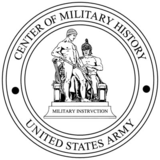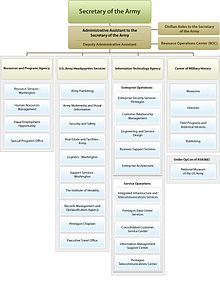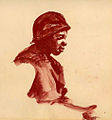- United States Army Center of Military History
-
United States Army Center of Military History Active July 1943–present Country United States Allegiance United States of America Branch United States Army Role Historical Research Part of The Center is a Directorate within the Office of the Administrative Assistant to the Secretary of the Army. Headquarters Collins Hall; Fort McNair Website www.history.army.mil The United States Army Center of Military History is a Directorate within the Office of the Administrative Assistant to the Secretary of the Army. The Center is responsible for the appropriate use of history throughout the United States Army. Traditionally, this mission has meant recording the official history of the Army in both peace and war, while advising the Army Staff on historical matters.
Contents
Mission
The Center traces its lineage back to historians under the Secretary of War who compiled the Official Records of the Rebellion, a monumental history of the Civil War begun in 1874, and to a similar work on World War I prepared by the Historical Section of the Army War College.
The modern organization of the Army's historical efforts dates from the creation of the General Staff historical branch in July 1943 and the subsequent gathering of a large team of historians, translators, editors, and cartographers to record the official history of World War II. This team began publication of the United States Army in World War II series (the well-known "green books"), which numbers 79 volumes. Since then, the Center has produced detailed series on the Army's role in the Korean and Vietnam Wars and has begun a series on the U.S. Army in the Cold War. These works, supplemented by hundreds of monographs and other publications on a rich mix of topics, have made the Center one of the major publishers of military history in the world.
Since its formation, the Center has provided historical support to the Army Secretariat and Staff, contributing essential background information for decision making, staff actions, command information programs, and public statements by Army officials. Over the decades it also has progressively expanded its role in the vital areas of military history education, the management of the Army's museum system, and the introduction of automated data-retrieval systems. The Center's work with Army schools ensures that the study of history is a significant part of the training of officers and noncommissioned officers. It also supports the use of history to foster unit pride and give today's soldiers an understanding of the Army's past. Much of this educational work is also performed at field historical offices and in Army museums. The Center thus provides all levels of the Army, as well as other services, government agencies, and the public, with a growing awareness of history that goes well beyond publications alone.
Historical activities
Under the direction of the Chief of Military history and his principal adviser, the Army’s Chief Historian, CMH’s staff is involved in some 50 major writing projects. Many of these efforts involve new research that ranges from traditional studies in operational and administrative history to the examination of such areas as procurement, peacekeeping, and the global war on terror. Those works under way and projected are described in the Army Historical Program, an annual report to the Chief of Staff on the Army’s historical activities. All Center publications currently in print are listed in the catalog Publications of the United States Army Center of Military History, which explains how to access them. Many publications also appear on the Center’s Web site.
In addition, Army historians maintain the organizational history of Army units, allowing the Center to provide units of the Regular Army, the Army National Guard, and the Army Reserve with certificates of their lineage and honors and other historical material concerning their organizations. The Center also determines the official designations for Army units and works with the Army Staff during force reorganizations to preserve units with significant histories, as well as unit properties and related historical artifacts.
Underscoring the importance of oral history to an understanding of the past, CMH serves as a clearinghouse for the oral history programs in the Army at all levels of command. It also conducts and preserves its own oral history collections, including those from the Vietnam War, Desert Storm, and the many recent contingency operations. In addition, the Center’s end-of-tour interviews within the Army Secretariat and Staff provide a basis for its annual histories of the Department of the Army.
As tangible representations of the service’s mission, military artifacts and art enhance the soldier’s understanding of the profession of arms. CMH manages a system of more than 120 Army museums and their holdings, encompassing some 450,000 artifacts and 15,000 works of military art. The Center also provides professional museum training, staff assistance visits, teams of combat artists such as those deployed under the Vietnam Combat Artists Program, and general museum support throughout the Army. Current projects include the establishment of a National Army Museum at Fort Belvoir, Virginia, and a complementary Army Heritage and Educational Center at Carlisle Barracks, Pennsylvania.
The Chief of Military History is responsible for ensuring the appropriate use of military history in the teaching of strategy, tactics, logistics, and administration. This mission includes a requirement that military leaders at all levels be aware of the value of history in advancing military professionalism. To that end, the Center holds a biennial history conference and workshop; publishes Army History, a professional bulletin devoted to informing the larger military history education community; and supplies readings for the Army school system, including the ROTC community, and texts and other support for the Army’s staff ride program. In this effort, the Chief of Military History is assisted by a historical advisory committee that includes leading academic historians and representatives of the Army school system.
Staff rides enable military leaders to retrace the course of a battle on the ground, deepening their understanding of the recurring fundamentals of military operations. As one of the Army’s major teaching devices, staff rides are particularly dependent on a careful knowledge of military history. Center historians lead rides directed by the Secretary of the Army and the Chief of Staff and attended by senior members of the Army Staff.
The responsibilities of the Chief of Military History have also thrust the Center into the national and international historical arena. It administers the Army’s far-flung Command History Program, to provide historical support to Army organizations worldwide. In addition, since the first Persian Gulf War, the Center has coordinated the deployment of military history detachments and the collection of historical data during peacekeeping and wartime operations, including those in northern Iraq, Somalia, Haiti, Bosnia, Kosovo, Afghanistan, and Iraq.
Fellowships and publications
To stimulate interest in military history in the Army and the nation, CMH sponsors professional programs.
- Fellowships: To encourage and support dissertations in military history by graduate students, the Center offers up to four dissertation fellowships each academic year. These fellowships carry a $9,000 stipend and access to the Center’s facilities and expertise. Although the fellowship program broadly defines the history of war on land, it selects winners with a preference for topics on the history of the U.S. Army. Inquiries should be addressed to the Chief Historian.
- Publications: The Center is particularly interested in projects of contemporary interest, such as expeditionary combat, multinational peacekeeping, NATO enlargement, humanitarian relief, nation-building, noncombatant evacuation, antiterrorism, and the management of change. In these areas the Center is able to facilitate research, provide graphics and editorial support, and carry manuscripts through to publication.
Historical services to the public
CMH’s art and documents collections, library, and reference services are available to private researchers. Official priorities permitting, its historians, curators, and archivists advise researchers on military history and stand ready to share their expertise concerning the location of sources. The Collections Branch of the Museum Division arranges temporary loans of paintings and drawings from the Army Art Collection to private organizations that agree to display the art publicly in accordance with Army regulations. The Army’s museums and historical holdings throughout the country and abroad are open to the public, and their curators are available to answer reference questions. Inquiries about these programs and services should be addressed to CMH’s Executive Officer.
Image Gallery
See also
- Military History Detachment
- National Museum of the United States Army #Other Army museums
- United States Marine Corps History Division
- Naval History & Heritage Command
- Department of Defense Historical Advisory Committee
- Vietnam Combat Artists Program
Further reading
The following publications provide additional information about the activities, services, and products of the Center of Military History:
- U.S. Army History CMH Online Bookshelves
- History of "History" in the U.S. Army
- Publications of the United States Army Center of Military History
- Army Historical Program(by fiscal year)
- Guide to U.S. Army Museums
- Oral History: Techniques and Procedures
- The U.S. Army Art and Photo Collection
- Army History (a professional bulletin)
- Organizational History
External links
 This article incorporates public domain material from websites or documents of the United States Army Center of Military History.
This article incorporates public domain material from websites or documents of the United States Army Center of Military History.- Home page. United States Army Center of Military History (USACMH) official website
- Gough, Terrence J. The U.S. Army Center of Military History: A Brief History
- Frequently Asked Questions (including personnel records, casualties, unit histories, medals and awards, unit patches and insignia, and burial sites). USACMH official website
Leadership Secretary of the Army · Under Secretary of the Army · Chief of Staff · Vice Chief of Staff · 4-star generals · Sergeant Major of the Army · House Armed Services Committee (House Subcommittee on Air and Land Forces) · Senate Committee on Armed Services (Senate Subcommittee on Air and Land Forces)

Components and
commandsArmy CommandsService ComponentsForces · Africa · Central · Europe · Pacific · North · South · Special Operations · Surface Deployment and Distribution · Space and Missile Defense
Direct Reporting UnitsNetwork Enterprise Technology · Medical · Intelligence and Security · Criminal Investigation · Corps of Engineers · Military District of Washington · Test and Evaluation Command · Military Academy · Reserve · Acquistion Support Center · Installation Management
Field ArmiesBranchesAcquistion Corps · Adjutant General's Corps · Air Defense Artillery Branch · Armor Branch · Aviation Branch · Army Band · Chaplain Corps · Chemical Corps · Civil Affairs Corps · Corps of Engineers · Dental Corps · Field Artillery Corps · Finance Corps · Infantry Branch · Inspector General's Corps · Judge Advocate General's Corps · Logistics Branch · Medical Corps · Medical Service Corps · Medical Specialist Corps · Military Intelligence Corps · Military Police Corps · Nurse Corps · Ordnance Corps · Psychological Operations Corps · Quartermaster Corps · Signal Corps · Special Forces · Transportation Corps · Veterinary Corps
Installations Training Uniforms and insignia Equipment History and traditions History · Continental Army · National Army · Army of the United States · United States Army Air Forces · Center of Military History · Institute of Heraldry · America's Army · Army Art Program · Army Band · Old Guard Fife and Drum Corps · Flag · National Museum · Rangers · Soldier's Creed · The Army Goes Rolling Along · Draft · Service numbersCategories:
Wikimedia Foundation. 2010.














